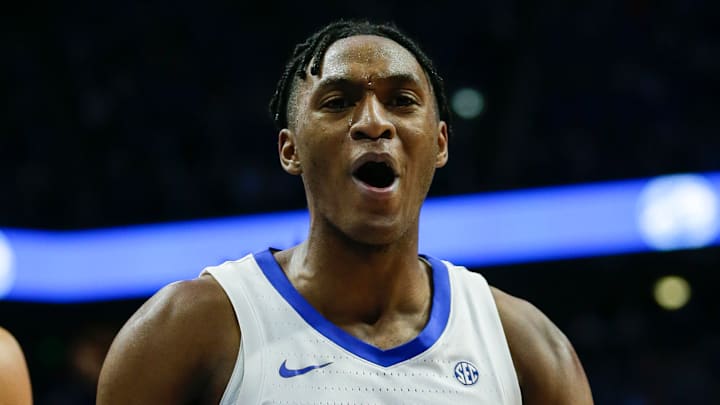Kentucky basketball became synonymous with the one-and-done era under John Calipari. From John Wall to Anthony Davis to De’Aaron Fox, Lexington has often been a pit stop for NBA-bound phenoms. But every so often, a player bucks the trend—choosing to return and leave a different kind of legacy.
With Otega Oweh opting to stay in Lexington for another season, it’s a rare but powerful reminder of what continuity can mean in college basketball. Here's a look back at some of the most impactful Kentucky players who returned since 2010 and how their follow-up seasons shaped the Wildcats—and their futures.
The return that won a title

Doron Lamb, Darius Miller, Terrence Jones
When this trio returned to join Anthony Davis and Michael Kidd-Gilchrist, the 2011-12 Wildcats were unstoppable. None saw a massive statistical leap—Lamb averaged 13.7 PPG, Miller accepted a bench role, and Jones dropped slightly from 15.7 to 12.3 PPG—but their experience was invaluable. The result? A 38-2 record and Kentucky’s eighth national championship.
Their decision to return added maturity and poise to a loaded roster of freshmen stars—a formula that worked to perfection.
Defensive anchors and determined veterans

Willie Cauley-Stein
Cauley-Stein returned twice, transforming from a raw athlete into the SEC Defensive Player of the Year by 2015. His blocks (2.9 to 1.7 BPG) and steals (1.2 SPG both years) anchored two Final Four runs, including the 38-1 team in 2014-15. His leap wasn’t just statistical—it was leadership and intimidation in the paint.
Alex Poythress (Four-Year Wildcat)
Poythress never became a star due to injuries, but his perseverance and versatility made him a fan favorite. He recovered from a torn ACL to average 10.2 PPG and 6.0 RPG as a senior in 2015-16. Though his numbers fluctuated, Poythress embodied toughness.
The return of the Harrison twins and a historic Run

Andrew & Aaron Harrison
The 2014-15 team became a modern marvel at 38-1, and the returning core had everything to do with it. Andrew ran the show (3.6 APG), and Aaron remained a clutch shooter (11.0 PPG). Their return gave Calipari the confidence to platoon—a strategy that nearly led to a perfect season.
Guards who grew into leaders

Tyler Ulis
Ulis exploded as a sophomore, posting 17.3 PPG and 7.0 APG while playing a staggering 36.8 minutes per game. He earned SEC Player of the Year and All-American honors. Few Kentucky players have made a bigger sophomore leap.
Isaiah Briscoe
Briscoe refined his game and added playmaking (4.2 APG), leading a backcourt that included De’Aaron Fox and Malik Monk. His improved efficiency, versatility, and leadership helped guide a 32-win season.
Those who took time to bloom

PJ Washington
Washington’s return was transformative. His averages jumped to 15.2 PPG and 7.5 RPG, and his improved 42.3% three-point shooting made him a lottery pick. He led Kentucky to the Elite Eight, proving patience pays off.
Nick Richards
After two years of raw promise, Junior Nick Richards (iykyk) emerged as one of the nation’s top bigs: 14.0 PPG, 7.8 RPG, and 2.1 BPG. His development under Kenny Payne was a masterclass in player growth.
Immanuel Quickley
Quickley’s story might be the most underrated. From bench guard to SEC Player of the Year, he averaged 16.1 PPG and became a lights-out shooter (42.8% from deep). His return sparked a dominant SEC season.
Chasing experience in a changing era
The transfer portal changed a lot, but it also meant a large portion of players could now come back at different schools in better positions. Case in point:

Oscar Tshiebwe
After winning National Player of the Year, Tshiebwe thrilled everyone by returning. Though Kentucky didn’t make a deep run, he still averaged 16.5 PPG and 13.7 RPG. His presence kept the Wildcats nationally relevant.
What Otega Oweh's return means
Oweh’s decision to return is a signal of belief—both in himself and in Mark Pope’s system. While Kentucky is embracing a new era, there’s power in continuity. Oweh now has the chance to join the likes of Ulis, Washington, and Quickley—players who became stars not by leaving early, but by coming back stronger.
Final thought
Kentucky's brand may always be tied to NBA pipelines, but its most complete teams—and most beloved players—often include those who stayed. If history is any guide, Oweh's return could be the difference between a good team and a great one.
